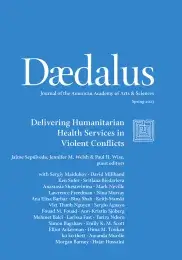
Introduction
Two hundred seventy-four million people—one in thirty people on the planet—are in humanitarian need as of September 2022. More than one hundred million of these individuals are displaced, usually as a result of crisis: conflict, political upheaval, economic meltdown, or climate shocks. In a humanitarian crisis, health is the most urgent and paramount need. But today the system for preventing and addressing humanitarian crisis is failing, and with it, the health needs of millions of vulnerable people are under threat. From treating childhood acute malnutrition to delivering COVID-19 vaccines to ensuring access to sexual, reproductive, maternal, and newborn health, health care in humanitarian contexts requires a dramatic rethink amid growing challenges to access and service delivery.
Identifying Contemporary Civil Wars’ Effects on Humanitarian Needs, Responses & Outcomes
Contemporary civil wars are highly complex processes involving a myriad of nonstate, state, civilian, and external actors. These actors develop systems of relationships that evolve during conflict and affect humanitarian needs, responses, and outcomes. This is because humanitarian actors are not isolated from but are part of these social systems. Their activities are constituted by and are constitutive of the interactions between the internal and external actors engaged in civil wars. This essay advances an analytical framework for mapping systems of relationships between the actors at the center of contemporary civil wars to understand how the relationships established by humanitarians transform for reasons outside of their control. This framework highlights the contingency inherent in wartime humanitarian activities in general, and health care provision in particular, and the need for locally informed, adaptive humanitarian practices in changing conflict environments.
Humanitarian Challenges of Great Power Conflict: Signs from Ukraine
Until the Russian invasion of Ukraine, there was little evidence of what a conventional war between the regular forces of peer competitors might look like today. After the total war of the twentieth century, the evolution of precision-guided munitions and drones set up the possibility of a new ideal type of conflict, in which U.S.-NATO coalitions could quickly defeat the regular forces of much weaker opponents, largely from a distance, while avoiding excess loss of civilian life. “Smart” weapons created the perception that when civilians were killed, this was an operational failure. Russia’s approach to war, however, has not put a high priority on avoiding civilian casualties, but has shown that precise weapons could be used deliberately to target civilian infrastructure in ruthless and coercive air campaigns. In this essay, I suggest that the Russia-Ukraine War provides insight into what a major power war would look like. I contrast the two distinct approaches represented by Ukraine, strengthened by NATO weapons and informed by its concepts, and Russia, with its readiness to attack civil society. I focus on the resulting humanitarian disaster in Ukraine, where more than one-quarter of the population has been displaced and where Ukrainians in Russian-occupied territories have reported thousands of instances of war crimes. I conclude by considering the likelihood and potential consequences of Russia’s use of nuclear weapons.
Challenges for Ethical Humanitarian Health Responses in Contemporary Conflict Settings
This essay examines the pressures and narratives that constrain humanitarian health actors from meeting their commitments to ethical conduct. I focus on critical contemporary issues that exacerbate or generate new ethical concerns for humanitarians, such as the imperatives to be accountable to affected populations, to “decolonize” humanitarianism, and to respect intersectional diversity; and how maleficence should be interpreted in this changing context. I argue that by adopting certain practices—particularly those that create space for new voices and confront entrenched power systems—today’s humanitarian health actors can remain true to their core ethical principles.
Humanitarian Health Responses in Urban Conflict Zones
War has long tested the design, capacity, and protected status of health care personnel and systems. In recent years, however, urban conflict zones have come to exemplify many of the most intractable humanitarian dilemmas around the delivery of medical care. In this essay, I examine several recurring dilemmas concerning operational independence and physical safety, as encountered in Syria and Yemen. I argue that, as a generative force, war has the potential to make (and remake) social, economic, and political life in urban settings in ways that accentuate essential challenges facing the safe and principled delivery of health care. These far-reaching effects leave humanitarians and their supporters to adapt existing strategies, many developed in more rural contexts, to shifting urban environments. In such contexts, the establishment of “hospital” or “relief zones” may offer a pragmatic and principled strategy to mitigate many of the dilemmas surrounding the protection of medical facilities and personnel in urban conflict settings.
The Great Evasion: Human Mobility & Organized Crime in Mexico & Its Borders
Mexico finds itself at the epicenter of unprecedented migration flows. Governments, international organizations, and civil society institutions, however, choose to ignore the current weight of organized crime in the matter. I shape the central thesis of this essay through an account of the phenomenon’s evolution, starting in the 1970s. I conclude by analyzing the ongoing migration issue along Mexico’s borders with Central America and the United States, while offering recommendations to improve conditions of a migratory problematic made worse by the denial of its existence.
In Their Shoes: Health Care in Armed Conflict from the Perspective of a Non-State Armed Actor
The protection of health care in armed conflict dates to the 1864 Geneva Convention. Yet violations of international humanitarian law related to the protection of health care occur on a near daily basis, and conflict actors continue to obstruct health care actors from assisting people in need in conflict areas. An estimated one-third of the recorded threats affecting health care are attributed to non-state armed actors (NSAAs). Yet given that many NSAAs themselves do in fact provide and facilitate health care, this essay considers NSAAs not just as threats but, in line with international human rights law, also as potential facilitators, providers, and promotors of health care. We discuss the specific case of Northeast Syria, where one NSAA has de facto control of the territory, and examine the level of involvement of NSAAs in the respect, protection, and provision of health care. We also explore some opportunities and challenges in engagement between humanitarian actors and NSAAs on health care provision, with an emphasis on seeing health care from the perspective of the NSAAs themselves.
Governing Data: Relationships, Trust & Ethics in Leveraging Data & Technology in Service of Humanitarian Health Delivery
Across the humanitarian sector, “data” permeate and inform responses to violence, disaster, and health-related crises. Delivering health care in humanitarian emergencies or conflict contexts requires many types of data: numbers and narratives about patients, staff, disease, treatment, and services. Multiple demands drive data collection at various levels, too often resulting in a mismatch between the tenets of data minimization (collect only what you need) and usage (use all you collect). Donors mandate specific data collection via both official reporting and ad hoc, informal requests, and humanitarians share data with other humanitarians and with donors. In this essay, I examine the specific issue of sharing data between and among humanitarians and donor governments. I pay particular attention to governance and the often-overlooked relational dimension of data, their implications for trust, as well as the ethical questions that arise in light of existing debates about localization and decolonizing the humanitarian sector.
Talk Is Cheap: Security Council Resolution 2286 & the Protection of Health Care in Armed Conflict
In May 2016, as attacks on health care in armed conflicts were increasing globally, the United Nations Security Council adopted Resolution 2286, demanding warring parties comply with their international obligations to prevent and address such attacks. The resolution was adopted unanimously by the Council and cosponsored by eighty-five UN member states. New data collection and public attention on attacks against health care at the time signaled that, contrary to scholarly expectation, the Council might use tools already at its disposal to ensure compliance with the resolution. Yet in the years that followed, the Security Council and states took few concrete steps to implement Resolution 2286. In this essay, we identify and analyze barriers that prevented the use of existing structures and mechanisms to influence the conduct of war. We contend that the experience of Resolution 2286 can tell us a great deal about the value of such resolutions as a response to pressing issues of humanitarian concern.
Localizing Responses to Gender-Based Violence: The Case of Women-Led Community-Based Organizations in Jordan
While the rationale for localizing humanitarian health response is well established at the level of policy rhetoric, the operationalization of the concept and its mainstreaming into concrete practice still require clearer intentionality. With COVID-19 pushing more people further into vulnerability, placing local communities at the heart of humanitarian and development health efforts has never been more urgent. Focusing on Jordan, this essay brings attention to the significant toll of violence against women and girls in conflict-affected communities and the importance of empowering local actors with community knowledge and resources to prevent and respond to gender-based violence. The essay follows on from the research conducted for CARE Jordan’s She Is a Humanitarian report (2022) and draws on interviews I conducted with the heads of women’s organizations in the summer of 2022. The essay explores the role of local women humanitarian actors as frontline responders, the challenges that hinder their role, and the advantages such actors enjoy, which, if harnessed, can achieve gains in accountability, health service quality, and gender equality.
Localizing the NGO Delivery of Health from the Outside In
International health nongovernmental organizations (NGOs) can provide the necessary assistance and expertise to save lives in times of crisis. Health NGOs often bring innovation, expertise, and resources to those in need. However, many commentators have questioned whether the involvement of health NGOs impedes a country’s ability to rebuild its own health sector in ways that do not depend on foreign actors. Building on the results of our survey of almost one thousand public health NGOs in the summer of 2021, we find that health NGOs may be a unique set of organizations that allow for more local decision-making and employ local staff more often than other populations of NGOs. Health NGOs also have a comparatively greater focus on peace than NGOs from other sectors. The essay examines the pathways by which some health NGOs can both alleviate short-term suffering and help foster long-term localized health delivery.
